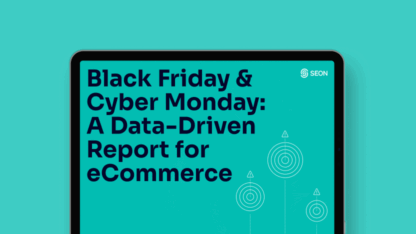Mid-market retailers generating $30-$500 million annually face an unprecedented fraud crisis. Global eCommerce fraud losses hit $44.3 billion in 2024 and are projected to skyrocket 141% to $107 billion by 2029. For these retailers, fraud isn’t just a security concern — it’s an existential threat to growth, profitability and customer trust.
Retail fraud presents diverse and persistent pain points, from stolen credit card usage to sophisticated account takeovers. For mid-market retailers, the struggle is intensified by fragmented fraud prevention systems, insufficient resources and reactive strategies that leave them vulnerable. The numbers paint a stark picture: US merchants lose $4.61 for every $1 of actual fraud, while North America accounts for 42% of global eCommerce fraud losses. But these statistics only scratch the surface. Retailers lose 2.9% of their total revenue to fraud annually — for a $100 million company, that’s nearly $3 million in direct losses before considering operational costs, reputation damage and lost opportunities.
Here, we look at the retail industry’s main pain points.
Balancing Risk and Revenue with Payment Fraud
Payment fraud has evolved from predominantly stolen credit card usage into a sophisticated ecosystem of criminal enterprises. Last year, 269 million card records and 1.9 million stolen US bank checks were posted on dark and clear web platforms. The explosion of card-not-present (CNP) transactions, accelerated by eCommerce growth, has created fertile ground for increasingly complex attacks.
Mid-market retailers grapple with a critical dilemma: how aggressively should they screen for fraudulent transactions to reduce false declines in eCommerce without turning away legitimate customers? Overly cautious fraud detection can harm customer experience and lower conversion rates, while overly lenient strategies risk greater exposure to fraud. Finding the right balance can determine whether a business grows or stagnates. This balancing act demands real-time, adaptive fraud prevention tools that can accurately detect nuanced fraud patterns without sacrificing sales.
Chargeback Frustrations: Limited Control, Maximum Losses
Chargebacks represent another significant retail headache. Even legitimate transactions may result in chargebacks when customers dispute charges with their banks, and retailers often find themselves ill-equipped to challenge these disputes effectively. Global chargeback volume is expected to grow 24% from 2025 to 2028, reaching 324 million transactions annually, costing merchants over $100 billion in 2025.
The average retail chargeback amount is $84, but the actual cost extends far beyond the transaction value. Each chargeback triggers administrative fees, operational overhead and potential penalties from payment processors. For mid-market retailers operating on thin margins, a surge in chargebacks can trigger a cascade of financial consequences: increased processing fees, frozen funds and, in extreme cases, loss of merchant accounts that effectively shut down online operations.
Sixty-one percent of chargeback disputes stem from friendly fraud — customers who make legitimate purchases then falsely claim unauthorized transactions to secure refunds while keeping the merchandise. This puts retailers in the impossible position of proving a negative while bearing the burden of proof. Retailers benefit from adopting dispute management solutions for ecommerce chargebacks that streamline evidence collection and effectively challenge illegitimate claims, enabling them to better protect their revenue.
Return Fraud: Striking the Right Balance
Return fraud exploded into a $103 billion problem in 2024, with 15.14% of all returns classified as fraudulent. The rise of online shopping has created new vulnerabilities: 60% of retailers report wardrobing incidents — customers purchasing items, using them, returning them for full refunds.
The sophistication of return fraud schemes would shock most business owners. Criminal rings orchestrate massive operations, using multiple promotional codes to purchase high-value items at discounted prices. Then, they return knockoffs or damaged goods for instant refunds. What appears to be a generous return policy becomes a profit center for organized fraud.
Retailers must continuously calibrate policies, balancing customer trust and satisfaction with stringent enough measures to prevent widespread exploitation. Solutions integrating customer behavior analytics with flexible return rules can significantly reduce return fraud without harming genuine consumer relationships.
Promo Abuse: Loyalty Gone Awry
Promotional campaigns designed to drive customer acquisition have become sophisticated fraud targets. And the scale is staggering: in one documented case, just 4,000 users created 137,000 fake accounts to exploit a single discount code, resulting in $14 million in annual losses. These aren’t individual customers bending rules, they’re organized operations with industrial-scale efficiency. Retailers must prevent promo code abuse in eCommerce before minor oversights snowball into multi-million-dollar losses.
Promotional abuse acts as a gateway for other types of fraud. Criminal rings use stacked discount codes to purchase high-value merchandise at deep discounts, then leverage those items for return fraud schemes or resale operations. The interconnected nature of these schemes means a seemingly minor promotional vulnerability can cascade into significant financial losses.
Retailers face the challenge of deploying these incentives to reward genuine loyalty without opening doors to abuse. Advanced analytics that identify abnormal usage patterns are critical.
Account Takeover: Protecting Customer Trust
Account takeover (ATO) fraud is increasingly prevalent and particularly damaging, as fraudsters seize legitimate customer accounts, steal stored payment information and make unauthorized purchases. ATO fraud has surged 285% for credit unions and 457% for community banks, indicating the industrial scale of these operations. Fraudsters now operate like legitimate businesses, with customer support, tutorials and service-level agreements guaranteeing successful account takeovers.
For retailers, ATO attacks destroy customer trust while creating complex liability scenarios. When customers’ accounts are compromised and used for fraudulent purchases, retailers face chargebacks, customer service costs and the nearly impossible task of rebuilding damaged relationships.
Retailers urgently need comprehensive ATO detection systems that monitor account behavior in real-time, detecting anomalies such as sudden shipping address changes or unusual login patterns. Effective solutions combine device intelligence, behavioral biometrics, and adaptive rule engines to secure customer accounts proactively.
Read the full eCommerce report now and discover how leading retailers are rethinking fraud prevention.
Download Here
Moving Beyond Reactive Approaches to Fraud
Forward-thinking retailers are discovering that superior fraud prevention creates competitive advantages beyond loss reduction. Advanced fraud detection systems enable higher approval rates for legitimate transactions, faster checkout experiences and the confidence to expand into new markets or customer segments without proportional risk increases. By stopping fraud before it starts, approving more good customers and reducing operational overhead through automation, retailers can convert fraud prevention investments into revenue growth.
Sources
- eCommerce Fraud to Exceed $107 Billion in 2029 – Juniper Research
- True Cost of Fraud™ Study: Ecommerce and Retail Report – U.S. and Canada Edition – LexisNexis
- Annual Payment Fraud Intelligence Report 2024 – Recorded Future
- What’s the true cost of a chargeback in 2025? – Mastercard
- Appriss Retail Annual Research – Business Wire
- Retailers are losing $100 billion a year from return fraud, bots and coupon stacking – CNBC
FAQ
Mid-market retailers can reduce false declines by adopting adaptive, real-time fraud detection solutions. Leveraging AI-driven scoring, SEON accurately identifies nuanced fraud patterns, allowing retailers to confidently approve legitimate transactions and minimize customer friction, boosting conversions without increasing risk.
Prevent promo code abuse by employing real-time analytics to detect unusual behaviors such as stacked discounts or mass account creations. SEON’s device fingerprinting and behavior analytics quickly flag suspicious patterns, enabling you to protect your revenue while maintaining attractive promotions for genuine customers.
Tools like device fingerprinting and digital footprint analysis help detect multi-account abuse. SEON uses unique device hashes and behavioral signals to instantly recognize when multiple accounts originate from the same device, effectively shutting down fraudulent promo code exploitation and preserving your promotional integrity.









